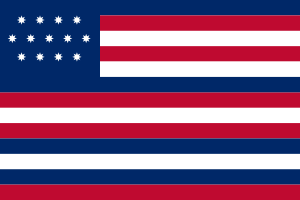Serapis flag facts for kids
The Serapis flag is a special early American flag. It was flown from a British ship called Serapis after it was captured by the United States.
Contents
A Flag for a New Ship
In 1779, during the American Revolutionary War, U.S. Navy Captain John Paul Jones fought a big sea battle. He captured the British ship Serapis. But his own ship, the Bonhomme Richard, sank. Its flag had been lost during the fight.
Jones now commanded the Serapis. But he had no American flag to fly on it. He sailed to a port called Texel. This port was controlled by the Dutch United Provinces, who were neutral. Officials from Britain said Jones was a pirate. They argued this because he sailed a captured ship without any known national flag.
How the Flag Was Described
A year before, an American diplomat named Arthur Lee wrote about U.S. ship flags. He said they should have "white, red, and blue alternately to thirteen" stripes. He also said they should have a "blue field with thirteen stars" in the corner.
Later, Benjamin Franklin and John Adams, who were ambassadors in France, wrote a similar description. They said the flag of the United States had "thirteen stripes, alternately red, white, and blue." They added that a "small square in the upper angle, next the flagstaff, is a blue field, with thirteen white stars, denoting a new constellation." This meant the stars showed a new group of states.
Making the Serapis Flag
Based on these descriptions, a flag was quickly made for the Serapis. Dutch records were updated to include a drawing of this flag. This made it official. So, the Dutch could recognize the flag. This helped avoid legal problems for Jones and his captured ship.
The original Dutch drawing of the flag still exists. It is labeled "Serapis" and dated October 5, 1779. This was just one day after another American flag, the "Alliance" flag, was recorded. The Alliance was another ship in Jones's fleet.
Unique Features of the Serapis Flag
There are five known drawings of U.S. flags with three-colored stripes. These flags appeared in European books for many years. They showed stars with 4, 5, or 6 points in different patterns.
The Serapis flag is special. It has four blue stripes that are not placed in a regular way. It also has 8-pointed stars. Even though it was flown as a U.S. flag and recognized by another country, it was different from the official U.S. flag. The Flag Resolution of 1777 said U.S. flags should have "alternate red and white" stripes.
Legacy of the Serapis Flag
The Serapis flag is also known as the "Franklin flag." This is because of the description given by Ambassador Franklin. In 2000, it was featured on a 33-cent postage stamp. This stamp was part of the U.S. Postal Service's Stars and Stripes series. The stamp was called the "John Paul Jones flag."
The United States Army also recognizes the Franklin Flag. It is the official flag of the 111th Infantry Regiment. This group is known as "The Associators." It was started by Benjamin Franklin in 1747. Soldiers from the 111th Infantry carried this flag into battle in 2009. This was during Operation Iraqi Freedom. The 111th Infantry Regiment is the only U.S. Army unit allowed to carry the Franklin (or "Serapis") flag.
This flag, along with the First Navy Jack, is shown on the crest of the USS John Paul Jones (DDG-53). The Serapis design is still popular today. Many flag sellers offer it for people who want historic U.S. flags.



